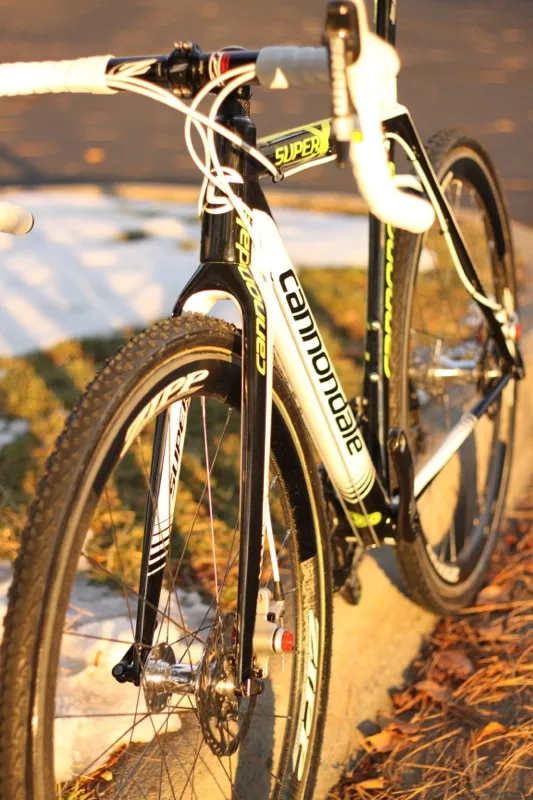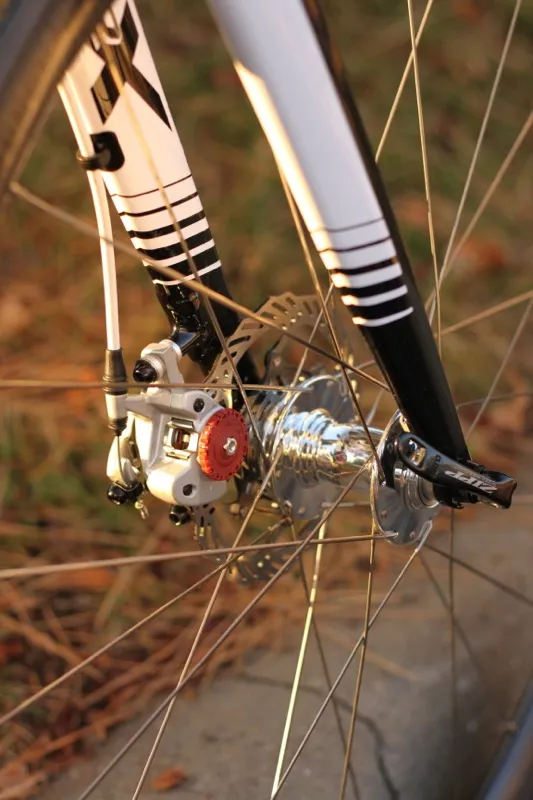Cannondale-cyclocrossworld.com rider, Tim Johnson, has had a trying year following up his phenomenal 2010 season. He and his teammates split wins at almost every major domestic race in the US last season, but this year he has only won twice. Interestingly, both of those wins came on his new Cannondale Super X disc prototype.
The courses Johnson won on couldn’t have been more different. His first win came at Jingle Cross on day 3, which was a UCI Category 1 event, making Johnson the first rider win on disc brakes at such a high UCI ranked level. “Every lap or race I can do on these things is going to teach me more about how they work, how they can be used, and also what Cannondale and SRAM can do to make their products better,” said Johnson. “That’s not bull, it’s really not — they’re awesome.”
The race was muddy, and featured the feared ascents and descents of Mount Krumpet; in short, the conditions were perfectly tailored to reward a rider with high performance brakes and mud clearances, the two main attributes touted by disc brakes.
Johnson’s second win, however, is likely more interesting for those following the development and acceptance of discs for ‘cross, it came this past weekend at Cyclo-cross LA, a UCI Category 2 event in Los Angles, CA. “We’re taking the opportunity to pin a number onto something that’s still in testing,” said Johnson.

Johnson's discs offer better braking performance and more mud clearance
What made this win more interesting were the course conditions: flat, with loose corners, and very fast with riders averaging over 30kph. “Changing something as big as the chassis and braking system is probably the biggest change [a rider can make],” said Johnson. “I was looking to this [past] weekend and week to get more time to try and figure out how it works, and whether or not it is really going to be the way to go. I’m trying to prove that now.”
For a course like this, conventional ‘pro’ wisdom would suggest a rider select for weight, but Johnson went with his slightly heavier disc bikes in an effort to continue to test how they affect his riding. “I wanted to spend more time on them, and even though it was going to be dry, probably flat, and extremely fast, I wanted to get a week on them,” said Johnson. “I decided to fly with them from Iowa to here [LA], and I’m glad I did, actually.”
Johnson said that the interest in the prototype bikes has been overwhelming. “The interest is just crazy,” said Johnson. “I was on a ride yesterday in the Hollywood hills and this guy rides up from behind and proceeded to talk my ear off for the next half hour. He was a moto guy, and was like, ‘whoa, discs on a road bike;’ because I had skinny [road] tires on for training. [Johnson has five pairs of Zipp 303s with disc hubs: two with Dugast Typhoon, two with Dugast Rhino, and one set of clinchers], and he said, ‘I can’t believe it has taken this long,’ this guy wanted to know exactly what was going on with the bike—it’s happening, and happening a lot."
The choice seemed to pay off with his second win of the season and for the disc-equipped bikes. And while, he admits that the brakes are impressive, but he doesn’t want to openly share more. “I can’t tell you much for publication, other than, I don’t think discs are just for muddy hilly courses,” said Johnson.
Johnson says he’ll still select the bikes on a case-by-case (or race-by-race) basis, for now, though we’ll surely see them on the course at the USGP in Bend, OR this weekend, 10-11 December. “I’m going to keep sampling,” he said.

Johnson is using a hopped up pair of Avid BB7 mechanical calipers




